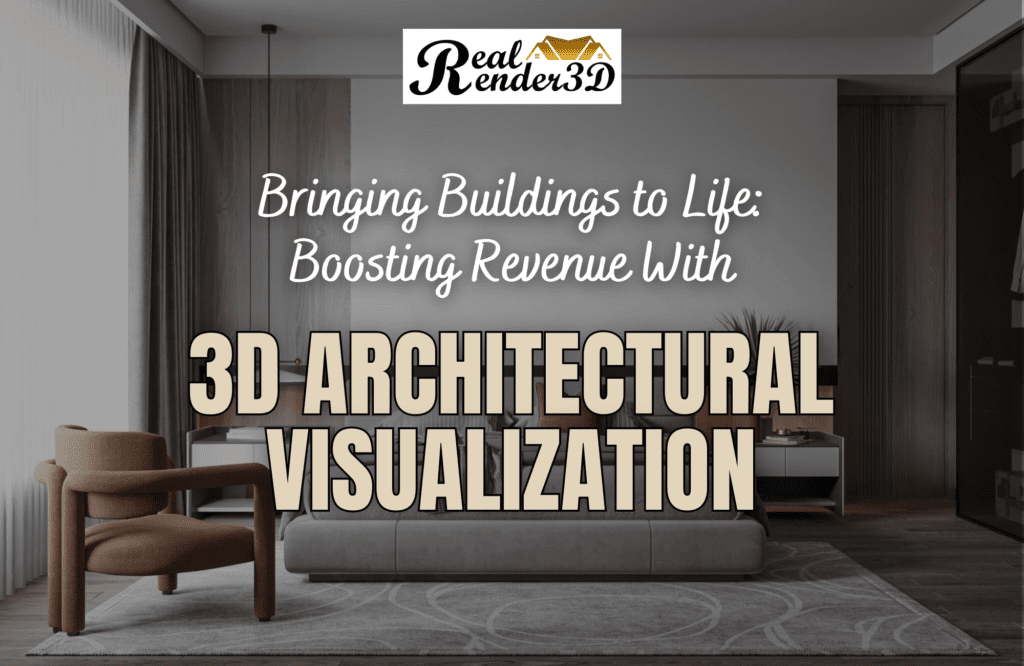Introduction
Bringing buildings to life before they are built is an art mastered by 3D architectural visualisation. This process creates photorealistic 3D renderings of architectural designs, allowing clients to fully experience the space and make informed decisions. Investing in high-quality 3D architectural visualisation can significantly boost revenue for architecture firms and construction companies. Here’s how.
Creates Emotional Connection
Stunning 3D interior rendering helps clients connect emotionally with the design. While 3D floor plans and elevations allow you to understand the technical details, photorealistic 3D visualisations transport you into the space. Clients can envision themselves living and working in the environment, forming a deeper appreciation and desire for the design. This emotional excitement fuels sales.
Simplifies Complex Designs
Some architectural designs are difficult to interpret from 2D drawings alone. 3D exterior rendering brings complex shapes and spaces to life. Clients can better understand unconventional forms and spatial relationships through detailed 3D visualization. Reducing confusion and uncertainty makes clients more likely to approve the design.
Speeds Up Decision Making
Seeing fully rendered 3D home design visuals enables clients to make faster decisions regarding the design. This streamlines the review and approval process, allowing projects to proceed on schedule. Accelerated decision making translates to an accelerated workflow and increased revenues.
Enhances Marketing
Using 3D floor plans in your marketing materials gives you a competitive edge. Clients are naturally drawn to the stunning visuals, which clearly communicate your design skills and vision. Share the visualizations on your website, proposals, social media and sales presentations to attract clients and boost your brand image.
Allows Early Visualization
Don’t wait until designs are finalized to create visualizations. Even rough 3D architectural visualisation communicates the concept clearly and fuels excitement. Creating renderings of preliminary designs enables early client feedback to refine the project. This saves significant time and money compared to making changes later in the process.
Enables Virtual Walkthroughs
With 3D architectural visualization, clients can embark on virtual walkthroughs of their future spaces long before construction begins. This creates an immersive experience that allows clients to provide detailed feedback. Identifying modifications during virtual walkthroughs is far simpler than after the build. Tweaking 3D models is much cheaper than altering physical structures.
Choosing the Right 3D Architectural Visualization Studio
To maximize benefits, partner with a trusted CGI company specializing in animation. Look for studios with extensive architectural rendering portfolios demonstrating photorealism and creativity. Opt for CGI studios employing 3D architectural visualizers skilled in using leading rendering software tools like 3ds Max, Revit, and V-Ray. Expert use of lighting and materials is needed to craft interior 3D designs and exterior house renderings that look real. For large projects, consider studios offering scalable 3D rendering services across distributed pipelines. Finally, choose studios that communicate well and welcome client feedback throughout the design process.
Realizing the Full Benefits
To gain the most advantage from architectural visualization, follow these best practices:
- Invest early – Begin visualization during initial design stages to enable early decision making.
- Focus on quality – Photorealistic renders best communicate designs, don’t cut corners.
- Think big – Use large-scale visuals like panoramas for maximum impact.
- Be strategic – Identify key views and focus time/resources on those.
- Share creatively – Develop engaging presentations, videos and VR experiences.
- Update iteratively – Refine visuals regularly to match evolving designs.
- Invite feedback – Get client input early and apply it quickly.
- Repurpose content – Reuse 3D models for other services like VR walkthroughs.
- Outsource strategically – Let visualization experts handle this specialist work.
Frequently Asked Questions
1. Why is 3D architectural visualization important?
3D architectural visualization is important because it brings designs to life through immersive visuals and enables clients to better understand and get excited about projects, accelerating decision-making and revenue.
2. How does 3D architectural visualization create emotional connections?
3D architectural visualization creates emotional connections by allowing clients to visually experience spaces in detail before they are built. This helps clients envision themselves in the environments, forming emotional bonds with the designs.
3. What are the benefits of early 3D architectural visualization?
Early 3D architectural visualization enables clients to provide feedback to refine designs when changes are cheaper. It also builds excitement around projects faster to accelerate decisions and revenue.
4. How can you maximize benefits from 3D architectural visualization?
Maximize benefits by starting visualization early, insisting on photorealistic quality, thinking big with visuals, identifying and focusing on key views, updating visuals iteratively, encouraging client feedback, repurposing assets, and outsourcing to experts.
5. Why should you outsource 3D architectural visualization?
Outsourcing 3D architectural visualization allows you to tap into specialist expertise rather than attempting to build in-house capabilities. Experts will deliver higher quality visuals more efficiently.
6. What emerging technologies are shaping 3D architectural visualization?
Emerging technologies like photogrammetry, 3D printing, virtual reality, augmented reality, AI rendering, and digital twins are shaping the future of 3D architectural visualization.
Alex Smith is a content writer at RealRender3D, writing informative articles on 3D rendering, interior design, architecture, and related topics.
With over 15 years of experience at top UK architecture and interior design firms, Alex leverages his expertise to write engaging content educating readers on AEC industry trends and best practices.
Connect with Alex at alex@realrender3d.co.uk.
